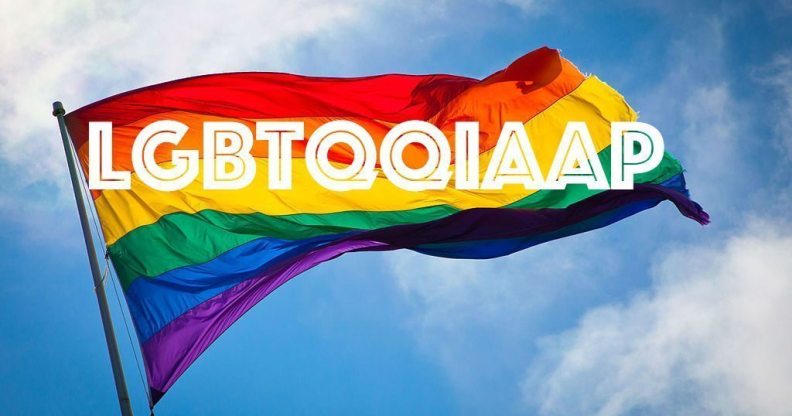How has the LGBT+ acronym evolved?

LGBT, the most commonly used acronym for the gay and trans community, stands for lesbian, gay, bisexual and transgender – but you already know that.
You probably also already know that the acronym has had rather a lot of letters added to it over the years, and that it now reads: LGBTKSWQPEXMGHDABJDKKLDLFSJFSJDNFJNDFJFBJFNFMLDKEEEYRHRHRFKF.
OK, fine, it actually reads: LGBTQQIAAP (plus or minus a letter or two).
Lesbian, gay and bisexual

LGBT has been used since the 1990s after it was adapted from LGB – which stood for lesbian, gay and bisexual. LGB replaced the term gay in reference to the LGBT community in the mid-to-late 1980s.
The L stands for lesbian – aka a woman who is attracted to other women, while the G stands for gay – aka a man who is attracted to other men. The B is for bisexual, so a person (male or female) who is attracted to both men and women.
Transgender

T, which stands for transgender, was next to gain a place on the acronym.
While the first three letters (LGB) focus on sexual identity, transgender refers to a person whose gender identity is different from the sex on their birth certificate.
However, not everyone who identifies as trans will take hormones or have sex reassignment surgery, and some don’t identify as a single gender, preferring gender-neutral pronouns such as ‘they’, ‘them’ and ‘theirs’.
Queer and questioning

Following the letter T was Q, which stands for Queer, and can be used as an umbrella term to represent anyone who’s non-cisgender and non-heterosexual.
In Stonewall’s glossary of terms, queer is listed as “a derogatory term for LGBT individuals” – but, the charity is keen to emphasise, this is “in the past”.
“The term has now been reclaimed by LGBT young people in particular who don’t identify with traditional categories around gender identity and sexual orientation,” the entry continues.
However, the organisation cautions, the term is “still viewed to be derogatory by some”.
The term queer is sometimes preferred because it is ambiguous and allows people to avoid the more rigid boundaries associated with labels like lesbian and transgender.
Another Q can be added for questioning – producing the variant LGBTQQ – which represents people who are still exploring their sexuality or gender identity.
Intersex

I stands for intersex – that is, a person “born with a reproductive or sexual anatomy that doesn’t seem to fit the typical definitions of female or male”, according to the Intersex Society of North America.
Experts believe that 0.05 to 1.7 percent of the population is born with “intersex traits”, meaning their body is not definitely male or female, possibly because they have chromosomes which are not XX or XY, or because their genitals or reproductive organs are not considered ‘standard’.
Asexual and ally

According to Stonewall, an asexual person (or ace) is defined as someone who does not experience sexual attraction for any gender.
However, there is a large amount of diversity among the asexual community, as there is among all LGBT+ communities, and, indeed, the straight community.
Like everyone else, asexual people respond to relationships, attraction and arousal in different ways.
Some asexual people are happier on their own, while some want to form intimate romantic relationships.
Just because they don’t want to have sex, they still enjoy the communication, closeness, fun, trust and all the other stuff that a partnership can provide.
Find out more about asexuality here.
Another A in the LGBT acronym can stand for ally, also known as a person who identifies as straight and cisgender but supports people in the LGBT+ community.
Pansexual

Pansexual is the P in the acronym, and refers to a person whose romantic, emotional and/or sexual attraction is not based on gender, biological sex or gender identity.
They may themselves be fluid when it comes to gender or sexual identity.
Other letters and symbols that crop up

+: The plus sign is there to include anyone’s identity that doesn’t fall under another letter, so it’s for the LGBT’s related communities.
U for unsure: People who are unsure about their sexuality, similar to questioning.
C for curious: Those who are curious about their sexuality, similar to questioning and unsure.
Another T for transvestite: A person who wear the clothes of the opposite sex, or cross-dresses.
2 or 2S for two-spirited: People who have both a masculine and a feminine spirit.
P for polyamorous: The practice of or desire for intimate relationships with more than one partner.
O for other: You guessed it – anyone else on the spectrum of gender and sexuality.

